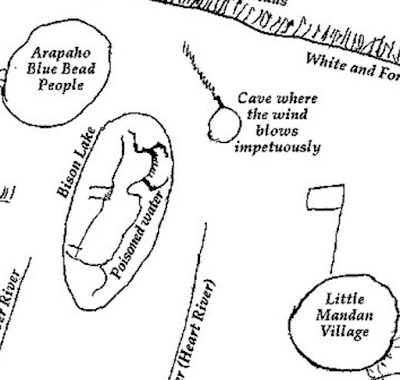Continuing last week's theme of comparative maps, here are a few examples of a genre of map that compares mountain heights and river lengths.
This map was originally published by Henry Tanner (1836) and modified by S, Augustus Mitchell (1846), both of Philadelphia. Like last week's map, the geography is arranged to fit the space with the shortest rivers cleverly positioned atop the tallest mountains.
The peaks are numbered. On this and the other maps from this period the highest known peak was Dhaulagiri in the Himalayas, now the seventh highest. In addition to mountains, the heights of cities and lakes are shown. Below Quito, Ecuador is shown beneath Pambamarca.
Down at the bottom are some of the Pyramids of Egypt, the "Falls of Niagara" and lakes such as Ontario (42), Erie (36) and Superioir (32). Above that is Caracas and the limit (this is a guess) of where bananas grow. Also along the bottom are various cities and landmakes such as the mines of Huancavilica and the Philadelphia Shot Tower. More of this map can be seen on the David Rumsey Map Collection page here.
Here are a couple more variations on this theme You can click them to see enlarged views from the Rumsey collection. This one published in London by William Darton in 1823 has everything arranged on one side.
I like the treatment of the rivers here.
This one (Joseph Thomas, London, 1835) has the rivers at the bottom and the mountains in several rows.
Finally, for a local view, here are the rivers of Scotland.
Many more examples of this theme can be seen on this excellent blog post from the Rumsey collection.
This map was originally published by Henry Tanner (1836) and modified by S, Augustus Mitchell (1846), both of Philadelphia. Like last week's map, the geography is arranged to fit the space with the shortest rivers cleverly positioned atop the tallest mountains.
Down at the bottom are some of the Pyramids of Egypt, the "Falls of Niagara" and lakes such as Ontario (42), Erie (36) and Superioir (32). Above that is Caracas and the limit (this is a guess) of where bananas grow. Also along the bottom are various cities and landmakes such as the mines of Huancavilica and the Philadelphia Shot Tower. More of this map can be seen on the David Rumsey Map Collection page here.
Here are a couple more variations on this theme You can click them to see enlarged views from the Rumsey collection. This one published in London by William Darton in 1823 has everything arranged on one side.
I like the treatment of the rivers here.
This one (Joseph Thomas, London, 1835) has the rivers at the bottom and the mountains in several rows.
Finally, for a local view, here are the rivers of Scotland.
Many more examples of this theme can be seen on this excellent blog post from the Rumsey collection.























